The Scoop on Beans
I’ve talked about beans (aka legumes) before. And I gotta talk about ‘em again because a constant flow of research continues to show they’re associated with a SO MANY health benefits.
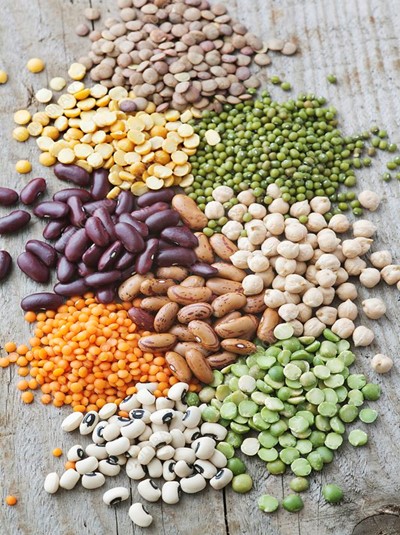
For instance, sifting through some half a million studies, nine independent research teams from around the globe created a landmark scientific consensus report (reviewed by 21 of the top cancer researchers in the world). One of their summary cancer-prevention recommendations is to eat whole grains and/or legumes (beans, split peas, chickpeas, or lentils) with every meal. Not every week or every day. Every meal.
Wondering how in the world do you eat beans at EVERY meal? Here’s one suggestion on how I manage this:
The Internet is loaded with ideas on how to include them in every meal. It’s easier than you might think.
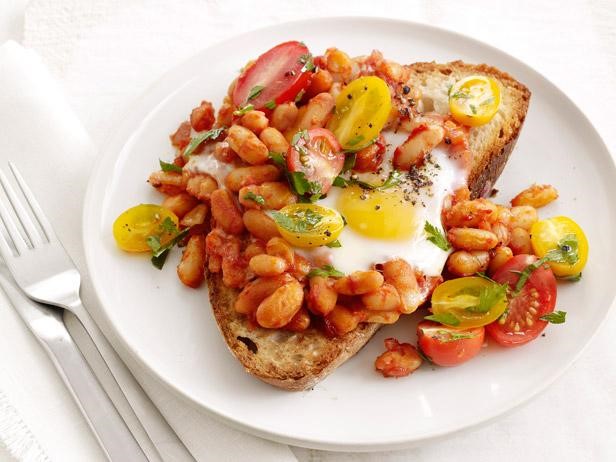
But back to the benefits of this miraculous food. Health studies have found disease is seriously curtailed when most of your plate is covered with vegetables, whole grains, and fruits. Legumes were given special treatment, straddling both the protein and the vegetable groups—it’s the best of both worlds.
Beans (like other vegetables) are loaded with protein, iron, and zinc, as you might expect from other protein sources like meat, but legumes also contain nutrients that are concentrated in the vegetable kingdom, including fiber, folate, and potassium. PLUS, they’re naturally low in saturated fat and sodium and free of cholesterol.
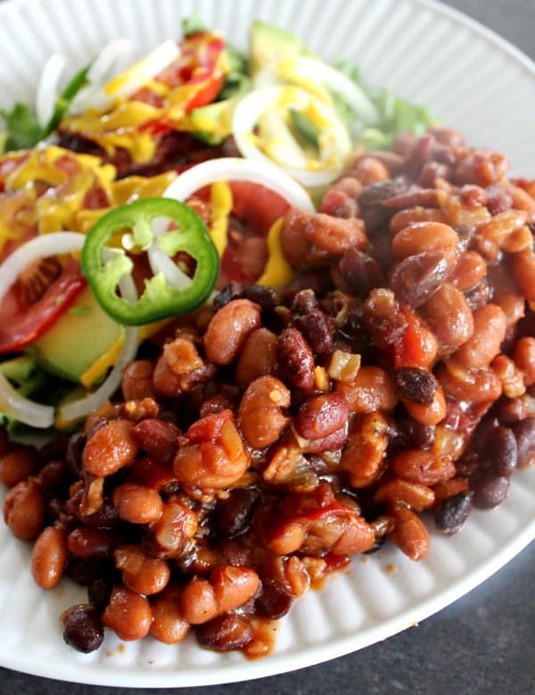
Eating legumes is associated with a slimmer waist and tummy fat and lower blood pressure, improving the regulation of blood sugar, insulin levels, and cholesterol. Their high load of fiber, folate, and phytates helps reduce stroke risk, depression, and colon cancer.
Also, they help with peripheral vascular disease and heart disease, they help prevent diabetes, they help prevent osteoporosis, they promote weight loss, they help heal leaky gut and promote healthy gut, they help heal Crohn’s disease, they help with fatty liver disease, they strengthen the immune system.
The list can go on, but the bottom line: they will increase your lifespan! And in a very tasty way, too!
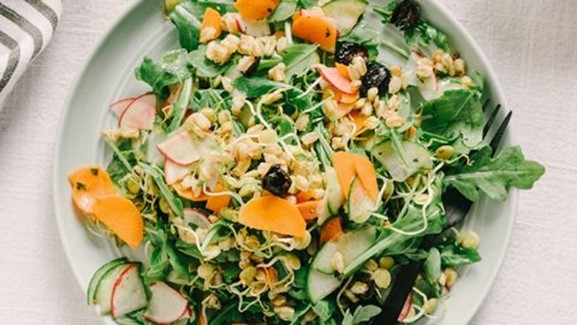
Legumes comprise all the different kinds of beans, including soybeans, split peas, chickpeas, and lentils. While eating a bowl of pea soup or dipping carrots into hummus may not seem like eating beans, it is. The goal is 3 servings/day (1/4 cup hummus or bean dip; ½ cup cooked beans, split peas, lentils, tofu, or tempeh; or 1 cup of fresh peas or sprouted lentils).
And they’re versatile. They can be added to any meal, easily incorporated into snack times, or served as the star attraction. The possibilities are endless. As an example of their versatility, I’ll close with a favorite “bean” recipe. Bean is in quotes because we don’t think of it as a bean recipe. It’s just a loaded sandwich incorporating hummus, but oh my is it good! I thank Terri Edwards of www.eatplant-based.com for this treasure!
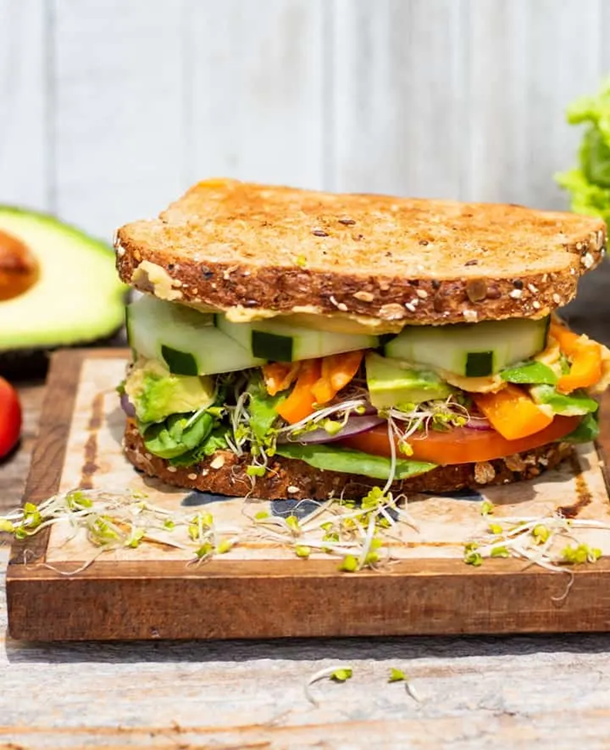
2 slices whole grain bread (or gluten free)
4 tablespoons homemade hummus divided
Veggies of choice including: lettuce, tomato, onions, avocados slices, bell peppers, pickles, bean sprouts, black olives, banana peppers, jalapenos, anything else you can think of.
salt to taste
pepper to taste
garlic powder to taste ((Johnny’s Garlic, found at Costco, is always a good choice)
HUMMUS
1 (15-ounce) can garbanzo beans or 1 ½ cups cooked garbanzo beans (aka chickpeas)
1/4 cup (scant) fresh lemon juice
1/4 cup well-stirred sesame tahini
1 clove garlic minced
2 tablespoons extra-virgin olive oil
1/4 teaspoon ground cumin
salt to taste
2 to 3 tablespoons water or aquafaba (the liquid in the bean can)
1 dash ground smoked paprika
Directions:
Add Recipe to Cook'n
blog comments powered by Disqus

For instance, sifting through some half a million studies, nine independent research teams from around the globe created a landmark scientific consensus report (reviewed by 21 of the top cancer researchers in the world). One of their summary cancer-prevention recommendations is to eat whole grains and/or legumes (beans, split peas, chickpeas, or lentils) with every meal. Not every week or every day. Every meal.
Wondering how in the world do you eat beans at EVERY meal? Here’s one suggestion on how I manage this:
- Breakfast: Beans on toast with avocado, sliced tomato, and a thin slice of red onion (and even a fried or scrambled egg!).
- Lunch: Hummus with veggie sticks.
- Dinner: Bean chili over a baked potato.
The Internet is loaded with ideas on how to include them in every meal. It’s easier than you might think.

But back to the benefits of this miraculous food. Health studies have found disease is seriously curtailed when most of your plate is covered with vegetables, whole grains, and fruits. Legumes were given special treatment, straddling both the protein and the vegetable groups—it’s the best of both worlds.
Beans (like other vegetables) are loaded with protein, iron, and zinc, as you might expect from other protein sources like meat, but legumes also contain nutrients that are concentrated in the vegetable kingdom, including fiber, folate, and potassium. PLUS, they’re naturally low in saturated fat and sodium and free of cholesterol.

Eating legumes is associated with a slimmer waist and tummy fat and lower blood pressure, improving the regulation of blood sugar, insulin levels, and cholesterol. Their high load of fiber, folate, and phytates helps reduce stroke risk, depression, and colon cancer.
Also, they help with peripheral vascular disease and heart disease, they help prevent diabetes, they help prevent osteoporosis, they promote weight loss, they help heal leaky gut and promote healthy gut, they help heal Crohn’s disease, they help with fatty liver disease, they strengthen the immune system.
The list can go on, but the bottom line: they will increase your lifespan! And in a very tasty way, too!

Legumes comprise all the different kinds of beans, including soybeans, split peas, chickpeas, and lentils. While eating a bowl of pea soup or dipping carrots into hummus may not seem like eating beans, it is. The goal is 3 servings/day (1/4 cup hummus or bean dip; ½ cup cooked beans, split peas, lentils, tofu, or tempeh; or 1 cup of fresh peas or sprouted lentils).
And they’re versatile. They can be added to any meal, easily incorporated into snack times, or served as the star attraction. The possibilities are endless. As an example of their versatility, I’ll close with a favorite “bean” recipe. Bean is in quotes because we don’t think of it as a bean recipe. It’s just a loaded sandwich incorporating hummus, but oh my is it good! I thank Terri Edwards of www.eatplant-based.com for this treasure!

Ultimate Veggie and Hummus Sandwich
Ingredients:
2 slices whole grain bread (or gluten free)
4 tablespoons homemade hummus divided
Veggies of choice including: lettuce, tomato, onions, avocados slices, bell peppers, pickles, bean sprouts, black olives, banana peppers, jalapenos, anything else you can think of.
salt to taste
pepper to taste
garlic powder to taste ((Johnny’s Garlic, found at Costco, is always a good choice)
HUMMUS
1 (15-ounce) can garbanzo beans or 1 ½ cups cooked garbanzo beans (aka chickpeas)
1/4 cup (scant) fresh lemon juice
1/4 cup well-stirred sesame tahini
1 clove garlic minced
2 tablespoons extra-virgin olive oil
1/4 teaspoon ground cumin
salt to taste
2 to 3 tablespoons water or aquafaba (the liquid in the bean can)
1 dash ground smoked paprika
Directions:
1. Blend all hummus recipe ingredients together until well-combined. Set hummus aside (or refrigerate).
2. Toast bread (optional).
3. Spread a thick layer of hummus on each bread slice.
4. Top with veggies of choice.
5. Season with salt, pepper, garlic powder, or any spice desired (oregano is another good choice).
6. Slice and eat.
2. Toast bread (optional).
3. Spread a thick layer of hummus on each bread slice.
4. Top with veggies of choice.
5. Season with salt, pepper, garlic powder, or any spice desired (oregano is another good choice).
6. Slice and eat.
Recipe formatted with the Cook'n Recipe Software from DVO Enterprises.
 Alice Osborne
Alice Osborne
Weekly Newsletter Contributor since 2006
Email the author! alice@dvo.com
Sources:
- www.sciencephoto.com
- www.foodnetwork.com
- www.gooddinnermom.com
- www.oursaltkitchen.com
- www.eatplant-based.com
